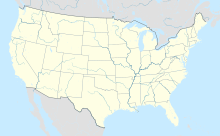Fort Claiborne facts for kids
Quick facts for kids Fort Claiborne |
|
|---|---|
| Perdue Hill, Alabama in United States | |

Location of Fort Claiborne located in the upper right of map
|
|
| Coordinates | 31°32′28″N 87°30′46″W / 31.54111°N 87.51278°W |
| Type | Stockade fort |
| Site information | |
| Owner | Private |
| Controlled by | Private |
| Open to the public |
No |
| Site history | |
| Built | 1813 |
| Built by | United States Army |
| In use | 1813-1816 |
| Battles/wars | Creek War |
Fort Claiborne was a military fort built in 1813. It was located in what is now Monroe County, Alabama. This fort was important during a conflict called the Creek War. It was a "stockade fort," meaning it was built with strong wooden walls to protect soldiers inside.
History of Fort Claiborne
The Creek War
In the fall of 1813, a general named Thomas Fluornoy gave an order. He told General Ferdinand Claiborne to move his soldiers up the Alabama River. General Claiborne had about 700 men with him. They were responding to a request from General Andrew Jackson.
The fort was first planned to help General Jackson. He wanted to attack Pensacola, but that attack never happened. General Claiborne started building the fort in November 1813. He built it on a place called Weatherford's Bluff and named it Fort Claiborne.
Fort Claiborne was a 200-square-foot fort. It had strong wooden walls and three blockhouses. Blockhouses are small forts with holes for shooting. It also had a special half-moon shaped gun area called a battery. This battery faced the Alabama River. It was there to protect the fort from attacks by boat.
While the fort was being built, Claiborne's soldiers bothered the Red Sticks. The Red Sticks were a group of Creek warriors. The soldiers tried to stop their messages with the Spanish in Pensacola. On November 28, Colonel Gilbert C. Russell arrived. He brought the 3rd U.S. Infantry Regiment with him. They also brought cannons for the fort's battery and small cannons called swivel guns.
In December 1813, General Claiborne wrote to General Jackson. He said he planned to attack the Red Sticks. On December 13, Claiborne's soldiers left the fort. They marched towards a Creek camp called Holy Ground. It was in what is now Lowndes County.
The soldiers marched to the tune of "Over the Hills and Far Away". Claiborne's group included the 3rd U.S. Regiment and volunteers from Mississippi. There was also a cavalry (horseback soldiers) group. Local soldiers led by Samuel Dale joined them. Choctaw warriors led by Pushmataha also helped.
On December 23, 1813, they fought the Battle of Holy Ground. After the battle, the American forces went back to Fort Claiborne. General Claiborne became sick and returned home. Colonel Russell then took command of Fort Claiborne.
After the Battle of Holy Ground, Colonel Russell wanted to attack more Creek villages. These villages were on the Cahaba River. But the trip was hard to plan because of supply problems. Russell wanted to avoid using regular workers for supplies. So, he ordered Captain James Dinkins to build two special boats called bateau. These boats would carry supplies and more soldiers. They were supposed to meet at the mouth of the Cahaba River.
The boats carried 70 soldiers and 69 barrels of supplies. They were even covered with makeshift armor. One boat had a swivel gun. They left Fort Claiborne on February 1, 1814. A group of soldiers led by Lieutenant Joseph M. Wilcox joined Russell's force. They reached the meeting spot, but Dinkins never arrived. Wilcox and five other soldiers went to find Dinkins. But Creek warriors attacked them. Russell returned to Fort Claiborne on February 18. After he came back, Dale's local soldiers were sent home.
Russell planned another trip up the Alabama River. He wanted to go to Hickory Ground with boats and Chickasaw and Choctaw warriors. But this trip never happened either.
Before the Battle of Horseshoe Bend, Colonel Russell was supposed to bring supplies. He was to go up the Alabama River to meet General Jackson. Jackson was at Fort Williams. Colonel Homer Milton was at Fort Decatur. They were all supposed to meet at Hickory Ground. But Jackson changed the plan. So, Russell never met up with the other forces.
After the Battle of Horseshoe Bend, General Thomas Pinckney took command of Fort Jackson. He told Colonel Milton and the 39th Infantry Regiment to bring Colonel Russell and the 3rd Infantry Regiment to Fort Jackson from Fort Claiborne.
Because of where it was built, Fort Claiborne helped stop Creek attacks. It made the southern part of their land safer. Fort Claiborne was not on the main Federal Road. But a smaller road connected it to the main road at Burnt Corn.
William Weatherford, a leader during the Creek War, lived at Fort Claiborne for a while. Local settlers were angry at him because of the Fort Mims massacre. They made him leave his home.
After the War
In 1816, a town called Claiborne was started near the fort. Soon, the town grew and covered the area where the fort was. A post office called Fort Claiborne was open from 1815 to 1822. John Watkins was the first postmaster there.
Today
Nothing is left of Fort Claiborne today. But a historical marker shows where it used to be. A stone monument was put near the site in 1939. It was placed there by the Alabama Society of Colonial Dames.
Military Units
Different military groups were stationed at Fort Claiborne. These included the 3rd and 4th Regiments of East Tennessee Militia. Also, the 1st and 2nd Regiments West Tennessee Militia were there at different times.



